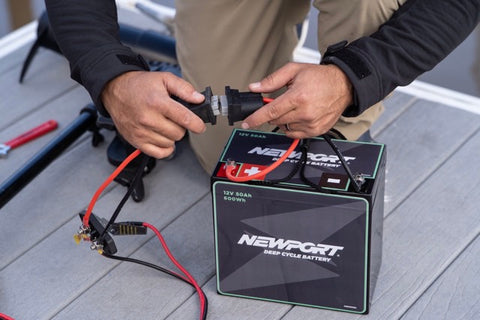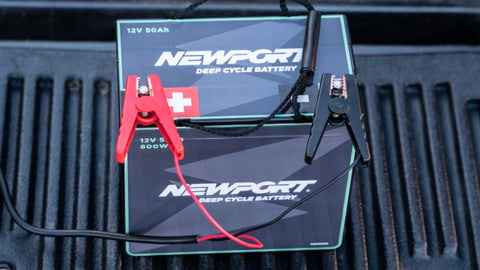How-To Get Up & Running: Newport 12V 50Ah Deep Cycle Battery
Unleash the freedom to embark on extended journeys, knowing that Newport's Deep Cycle Battery provides a reliable 12-volt output, perfectly suited for trolling motors and all your boating electronics. It's not just a battery; it's a commitment to long-lasting power and worry-free angling adventures. Let us guide you through the proper way to get up and running with your 12V 50Ah Deep Cycle AGM battery.
Newport's Official Quick Start Guide - 12V 50Ah Deep Cycle Battery
Connecting to the Battery Terminals:
When connecting your trolling motor to the battery terminals, it's crucial to ensure a secure and tight connection. Use appropriate tools to tighten the terminal connections, preventing any loose connections that could lead to power loss or damage. An adjustable wrench does the job!
Treating Electrical Connectors with Anti-Corrosive, Electrically Conductive Spray:
Before making any electrical connections, treat the terminals and connectors with an anti-corrosive, electrically conductive spray. This spray forms a protective barrier against corrosion, ensuring reliable electrical conductivity and minimizing the risk of connection issues over time.
Charging Before Initial Use:
Before using your 12V 50Ah Deep Cycle AGM battery for the first time, it's essential to fully charge it. This initial charge helps condition the battery and ensures maximum capacity and performance from the start. Avoid overcharging to prevent damaging the battery.
Connecting to Trolling Motor: Preferred Sequence:
When connecting your trolling motor or accessories to the power source, follow a specific sequence to minimize the risk of electrical issues or damage. Start by connecting the positive (+) terminal of the battery to the positive (+) terminal of the trolling motor, followed by the negative (-) terminals. This sequence helps maintain a stable electrical flow and reduces the risk of short circuits. If you’re using the Battery Quick Disconnect, disregard this sequence. We take care of this for you in the plug configuration.
Wiring in Series to Achieve 24V Power:
To achieve 24V power, you can wire two 12V deep cycle batteries in series. Connect the positive (+) terminal of one battery to the negative (-) terminal of the next battery, repeating this process until all batteries are connected. The final positive (+) terminal and negative (-) terminal will then connect to the 24V accessory you’re powering. This is a cost-effective way to power a NK180 kayak outboard while you save up to invest in a premium LiFePO4 battery source.
Wiring in Parallel:
Alternatively, you can wire two batteries in parallel to increase capacity while maintaining voltage. In a parallel configuration, connect all positive (+) terminals together and all negative (-) terminals together. This setup allows for longer runtime without increasing voltage, ideal for extending the range of your motor and length of your fishing trips.
Newport Battery Quick Disconnect:

Consider investing in a Newport Battery Quick Disconnect for added convenience and ease of use. This accessory allows for quick and effortless battery connections and disconnections, saving time and effort when setting up or storing your trolling motor and battery.
Charging After Using the Battery:

After using your deep cycle battery, it's crucial to recharge it promptly. This helps maintain the battery and extend its lifespan. Avoid leaving the battery in a discharged state for an extended period, as this can lead to irreversible damage. Use a quality battery charger compatible with AGM batteries and follow the charging recommendations in your owner's manual.

